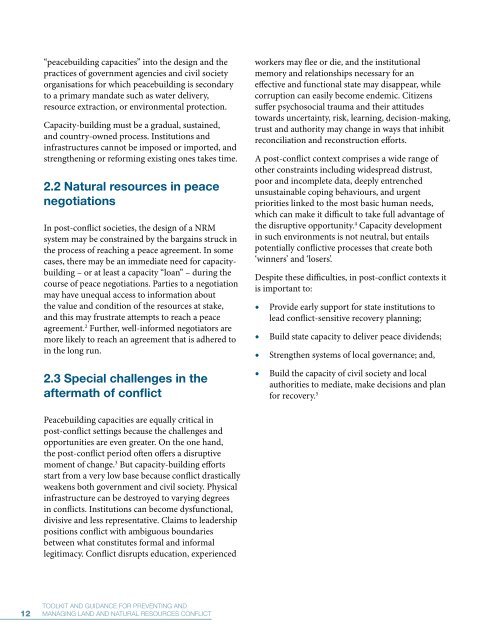Strengthening capacity - Disasters and Conflicts - UNEP
Strengthening capacity - Disasters and Conflicts - UNEP
Strengthening capacity - Disasters and Conflicts - UNEP
You also want an ePaper? Increase the reach of your titles
YUMPU automatically turns print PDFs into web optimized ePapers that Google loves.
“peacebuilding capacities” into the design <strong>and</strong> the<br />
practices of government agencies <strong>and</strong> civil society<br />
organisations for which peacebuilding is secondary<br />
to a primary m<strong>and</strong>ate such as water delivery,<br />
resource extraction, or environmental protection.<br />
Capacity-building must be a gradual, sustained,<br />
<strong>and</strong> country-owned process. Institutions <strong>and</strong><br />
infrastructures cannot be imposed or imported, <strong>and</strong><br />
strengthening or reforming existing ones takes time.<br />
2.2 Natural resources in peace<br />
negotiations<br />
In post-conflict societies, the design of a NRM<br />
system may be constrained by the bargains struck in<br />
the process of reaching a peace agreement. In some<br />
cases, there may be an immediate need for <strong>capacity</strong>building<br />
– or at least a <strong>capacity</strong> “loan” – during the<br />
course of peace negotiations. Parties to a negotiation<br />
may have unequal access to information about<br />
the value <strong>and</strong> condition of the resources at stake,<br />
<strong>and</strong> this may frustrate attempts to reach a peace<br />
agreement. 2 Further, well-informed negotiators are<br />
more likely to reach an agreement that is adhered to<br />
in the long run.<br />
2.3 Special challenges in the<br />
aftermath of conflict<br />
workers may flee or die, <strong>and</strong> the institutional<br />
memory <strong>and</strong> relationships necessary for an<br />
effective <strong>and</strong> functional state may disappear, while<br />
corruption can easily become endemic. Citizens<br />
suffer psychosocial trauma <strong>and</strong> their attitudes<br />
towards uncertainty, risk, learning, decision-making,<br />
trust <strong>and</strong> authority may change in ways that inhibit<br />
reconciliation <strong>and</strong> reconstruction efforts.<br />
A post-conflict context comprises a wide range of<br />
other constraints including widespread distrust,<br />
poor <strong>and</strong> incomplete data, deeply entrenched<br />
unsustainable coping behaviours, <strong>and</strong> urgent<br />
priorities linked to the most basic human needs,<br />
which can make it difficult to take full advantage of<br />
the disruptive opportunity. 4 Capacity development<br />
in such environments is not neutral, but entails<br />
potentially conflictive processes that create both<br />
‘winners’ <strong>and</strong> ‘losers’.<br />
Despite these difficulties, in post-conflict contexts it<br />
is important to:<br />
Provide early support for state institutions to<br />
lead conflict-sensitive recovery planning;<br />
Build state <strong>capacity</strong> to deliver peace dividends;<br />
Strengthen systems of local governance; <strong>and</strong>,<br />
Build the <strong>capacity</strong> of civil society <strong>and</strong> local<br />
authorities to mediate, make decisions <strong>and</strong> plan<br />
for recovery. 5<br />
Peacebuilding capacities are equally critical in<br />
post-conflict settings because the challenges <strong>and</strong><br />
opportunities are even greater. On the one h<strong>and</strong>,<br />
the post-conflict period often offers a disruptive<br />
moment of change. 3 But <strong>capacity</strong>-building efforts<br />
start from a very low base because conflict drastically<br />
weakens both government <strong>and</strong> civil society. Physical<br />
infrastructure can be destroyed to varying degrees<br />
in conflicts. Institutions can become dysfunctional,<br />
divisive <strong>and</strong> less representative. Claims to leadership<br />
positions conflict with ambiguous boundaries<br />
between what constitutes formal <strong>and</strong> informal<br />
legitimacy. Conflict disrupts education, experienced<br />
12<br />
TOOLKIT AND GUIDANCE FOR PREVENTING AND<br />
MANAGING LAND AND NATURAL RESOURCES CONFLICT

















